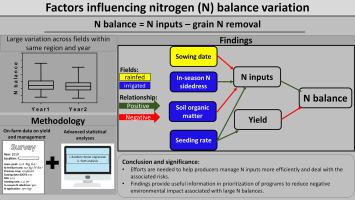Agricultural Systems ( IF 6.1 ) Pub Date : 2021-08-18 , DOI: 10.1016/j.agsy.2021.103245 Fatima A.M. Tenorio 1 , Eileen L. McLellan 2 , Alison J. Eagle 3 , Kenneth G. Cassman 1 , Jessica A. Torrion 4 , Patricio Grassini 1

|
CONTEXT
The nitrogen (N) balance provides an indication of the risk for N losses into the environment. Previous studies have shown large variation in N balance among producer maize fields in the US Corn Belt, even within the same region and year. However, little is known about the soil and management factors explaining variation in N balance and to what extent the influence of these factors on N balance occurs via grain yield, N inputs, or both.
OBJECTIVE
This study aimed to disentangle interactions among yield, management practices, and soil factors to identify which have the greatest influence on N balance in producer maize fields in Nebraska (USA).
METHODS
The database used contains yield and management records from 311 producer irrigated and rainfed fields sown with maize for two years (2010−2011). The N balance was estimated as the difference between N inputs (from fertilizer and applied irrigation) and grain N removal. Random forest regression and path analysis were used to assess the influence of soil and management factors on the N balance via either grain yield or N inputs for irrigated and rainfed fields.
RESULTS AND CONCLUSIONS
Analysis based on combination of advanced statistics showed that soil organic matter (SOM), seeding rate, sowing date, and in-season N sidedress influenced N balance, mostly via N inputs application and, to a lesser degree, grain yield. In many cases, producer risk behavior explained the relationship between N balance and soil and management factors. For example, N application was higher in fields that have lower SOM or received in-season N sidedress, without any yield advantage. The findings suggest that efforts are needed to help producers manage N inputs more efficiently and deal with the associated risks.
SIGNIFICANCE
Our study performed a novel field level assessment of factors influencing N balance which provides useful information in prioritization of agricultural research and extension programs to avoid large N balances and associated negative environmental impact.
中文翻译:

解开影响西部玉米带生产田氮平衡的管理因素
语境
氮 (N) 平衡提供了氮流失到环境中的风险的指示。先前的研究表明,即使在同一地区和同一年,美国玉米带生产者玉米田的氮平衡也存在很大差异。然而,人们对解释氮平衡变化的土壤和管理因素知之甚少,以及这些因素对氮平衡的影响在多大程度上通过粮食产量、氮输入或两者兼而有之。
客观的
本研究旨在解开产量、管理实践和土壤因素之间的相互作用,以确定哪些因素对内布拉斯加州(美国)生产玉米田的氮平衡影响最大。
方法
使用的数据库包含来自 311 个种植者灌溉和雨育田两年(2010-2011 年)种植玉米的产量和管理记录。氮平衡被估计为氮输入(来自肥料和应用灌溉)和谷物氮去除之间的差异。随机森林回归和路径分析用于评估土壤和管理因素通过灌溉和雨育田的粮食产量或氮输入对氮平衡的影响。
结果和结论
结合先进统计数据的分析表明,土壤有机质 (SOM)、播种率、播种日期和当季氮肥影响氮平衡,主要通过氮投入应用,在较小程度上影响粮食产量。在许多情况下,生产者风险行为解释了氮平衡与土壤和管理因素之间的关系。例如,在 SOM 较低或接受当季施氮的田地中施氮量较高,但没有任何产量优势。研究结果表明,需要努力帮助生产者更有效地管理氮投入并应对相关风险。
意义
我们的研究对影响氮平衡的因素进行了新的田间水平评估,这为农业研究和推广计划的优先排序提供了有用的信息,以避免大量的氮平衡和相关的负面环境影响。











































 京公网安备 11010802027423号
京公网安备 11010802027423号